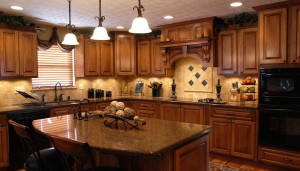Add A Kitchen Island To Your Home
For most kitchen remodels a kitchen island is often at the top of the wish list. It’s a great focal point as well as a functional tool for cooking, eating and meal prep. However, before you start dreaming up your kitchen island, ask yourself these questions:
1) Determine The Function
The way in which you want to use your kitchen island will influence your design decision. To analyze your island needs, consider a few basic functions:
- Storage. Create accessible and simple storage to keep clutter for piling up on the island. Consider installing drawers and cupboards under the island for containers, pots and pans and utensils. You can also utilize overhead racks for larger objects like pots and mixing bowls, cookbooks or wine bottles. Keep in mind serving and baking tray storage and consider installing tall and skinny drawers and compartments as well.
- Seating. You may want to have seating at the island if it’s a place you want the family to hang out. You can include a breakfast bar on one side with enough counter space to serve food. If you want to add a cooktop to your island, make sure the size of the island will accommodate it. Also, you can install a dual-height island, where the eating area is higher than the working area.
- Plumbing. Your island can have a small extra prep sink, dishwasher or disposal, which will give you more options for cleaning up.
- Electrics. Be sure to include multiple outlets for both safety and convenience—you don’t want extension cords running across the countertop.
2) Measure The Space
The size and shape of a kitchen island depend on the square footage and layout of the existing room. Make sure there is enough room around the island to move freely and for appliances to fully open. Kitchen islands are typically rectangular or square, but don’t be afraid of trying a different shape such as an oval or arc, or creating a perpendicular shape to suit the proportions of the room.
Make a life-sized template of your desired kitchen island out of paper or cardboard, tape it down on the floor and live with it for a day or two. As you continue to plan, keep these standard measurements in mind:
- Walkway between an island and existing cabinetry: 36 to 42 inches
- Counter height: 36 inches
- Breakfast bar height: 40 to 42 inches
3) Select Your Style
The island will become the center of attention in your kitchen. You can choose to keep the decor the same or, if your budget allows, you can update it with granite or quartz. Perhaps stain its wood base in a bold accent color or change up the hardware.
- Countertops. A stainless steel or cement surface on the island can put an industrial spin on a traditional kitchen. Or consider butcher block if you cook a lot or a marble surface set at a lower height if you’re a frequent baker.
- Cabinetry. A colorful painted base cabinetry adds pop in a neutral or white kitchen. Beadboard adds textural interest if the rest of the cabinetry is flat. To visually open up the space, the island can be set atop legs with open shelving.
Once you’ve considered all of these aspects of your kitchen island design, it’s time to call in the professionals. At Nailman Construction we can help bring your kitchen island design to life, while also providing professional recommendations and suggestions. To get started on your kitchen remodel today, give us call or click here for a quote.

